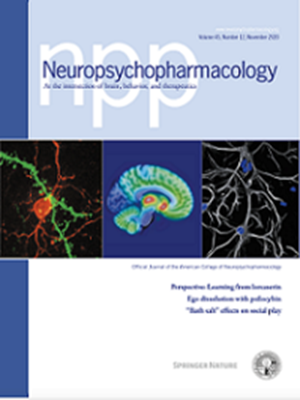通过抑制脂肪酸酰胺水解酶(FAAH)来提高阿南达明的疗效,结合互联网传递的认知行为疗法治疗创伤后应激障碍:一项随机、安慰剂对照的临床试验。
IF 6.6
1区 医学
Q1 NEUROSCIENCES
引用次数: 0
摘要
创伤后应激障碍(PTSD)是一种严重的精神健康障碍,治疗方案有限。黄金标准疗法包括认知行为疗法(CBT),它结合了创伤记忆的暴露来促进记忆的消失。CBT对PTSD有效,但效果不完全,且症状容易自发复发。药理学上促进恐惧消退可以增强暴露疗法的效果。在这里,我们探讨了内源性大麻素(eCB)系统,一个与恐惧消退密切相关的神经调节系统,是否会促进基于暴露的CBT的疗效。具体来说,我们测试了通过抑制eCB配体anandamide (AEA)的主要降解酶脂肪酸酰胺水解酶(FAAH)来提高AEA的效果。在这项双盲、安慰剂对照研究中,PTSD患者(N = 100;85名女性)被随机分配到FAAH抑制剂(FAAHi) JNJ-42165279 (25 mg b.i.d)或安慰剂组,持续12周。在第5-12周,所有参与者都完成了一项由互联网提供的CBT,其中包括基于暴露的模块。主要结局是临床医师评估的PTSD症状严重程度(CAPS-5)。次要结局包括自我报告的PTSD症状、抑郁、焦虑和睡眠质量。血液样本被用来测量药物和eCBs的水平。总的来说,PTSD症状随着时间的推移而改善。虽然FAAHi增加了AEA水平,但FAAHi对PTSD症状或任何次要测量没有影响。FAAHi联合网络CBT对PTSD症状的改善程度并不比单独网络CBT好。因此,FAAH抑制似乎不是一种合适的辅助治疗,以加强PTSD的CBT。本研究注册号为Eudra-CT 2020-001965-36。本文章由计算机程序翻译,如有差异,请以英文原文为准。

The efficacy of elevating anandamide via inhibition of fatty acid amide hydrolase (FAAH) combined with internet-delivered cognitive behavioral therapy in the treatment of post-traumatic stress disorder: a randomized, placebo-controlled clinical trial
Post-traumatic stress disorder (PTSD) is a severe mental health disorder with limited treatment options. Gold standard treatment includes cognitive behavioral therapies (CBT) that incorporate exposure to traumatic memories to facilitate extinction. CBT can be effective in PTSD, but effects are incomplete and symptoms are prone to spontaneous return. Pharmacologically facilitating fear extinction could potentiate the effects of exposure-based therapy. Here, we explored whether targeting the endocannabinoid (eCB) system, a neuromodulatory system critically involved in fear extinction, would promote the efficacy of exposure-based CBT. Specifically, we tested the effects of elevating the eCB ligand anandamide (AEA) via inhibition of its main degradative enzyme, fatty acid amide hydrolase (FAAH). In this double-blind, placebo-controlled study, patients with PTSD (N = 100; 85 women) were randomized to the FAAH inhibitor (FAAHi) JNJ-42165279 (25 mg b.i.d.) or placebo for 12 weeks. In weeks 5–12, all participants completed an internet-delivered CBT that included exposure-based modules. The primary outcome was clinician-assessed PTSD symptom severity (CAPS-5). Secondary outcomes included self-reported symptoms of PTSD, depression, anxiety, and sleep quality. Blood samples were taken to measure levels of drug and eCBs. Overall, PTSD symptoms improved over time. While FAAHi increased AEA levels, there was no effect of FAAHi on PTSD symptoms or any secondary measure. FAAHi combined with internet-delivered CBT did not improve PTSD symptoms to a greater extent than internet-delivered CBT alone. Thus, FAAH inhibition does not appear to be a suitable adjunct treatment for enhancing CBT in PTSD. This study was registered as Eudra-CT 2020-001965-36.
求助全文
通过发布文献求助,成功后即可免费获取论文全文。
去求助
来源期刊

Neuropsychopharmacology
医学-精神病学
CiteScore
15.00
自引率
2.60%
发文量
240
审稿时长
2 months
期刊介绍:
Neuropsychopharmacology is a reputable international scientific journal that serves as the official publication of the American College of Neuropsychopharmacology (ACNP). The journal's primary focus is on research that enhances our knowledge of the brain and behavior, with a particular emphasis on the molecular, cellular, physiological, and psychological aspects of substances that affect the central nervous system (CNS). It also aims to identify new molecular targets for the development of future drugs.
The journal prioritizes original research reports, but it also welcomes mini-reviews and perspectives, which are often solicited by the editorial office. These types of articles provide valuable insights and syntheses of current research trends and future directions in the field of neuroscience and pharmacology.
 求助内容:
求助内容: 应助结果提醒方式:
应助结果提醒方式:


